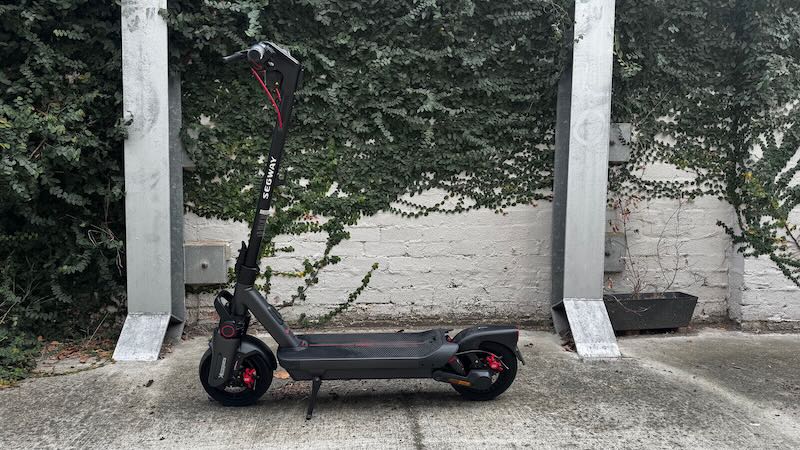I have just stepped into the most contested arena in mobility, eScooters.
To some they are the missing micro mobility piece of the active transport puzzle, as we seen from the recent NSW announcement on legalising eScooters in order to get people out of cars and provide the missing link with Public Transport.
To others they are demonic machines, cluttering streets, and putting their riders and pedestrians in daily peril. Thanks to the good people at Segway, I have been able to find out for myself, riding the Ninebot max G3 scooter loaned to me for the last couple of weeks.
I’m no stranger to the contested world of active transport. Whilst cars are immensely useful and essential for many, my family has been lucky enough to cultivate our own bike-based 15 minute city commute in inner Melbourne, supplemented by the occasional rental from GoGet, Turo or Hertz, electric where possible.
There is also no way to a zero carbon economy just by electrifying all vehicles one for one, growing the road vehicle fleet in proportion to the growing population, not to mention the road infrastructure to support these vehicles is just a source of further emissions through the manufacture and construction of these vehicles.
To achieve our climate goals we need more people to choose, active, shared and public transport. This shouldn’t be as controversial as it is, not least because more cars means more congestion, however they are powered.
In my own LGA, City of Yarra, the newly elected populist independent council, as one of its first actions, commenced dismantling the active transport infrastructure (protected bike lanes) that keep my family safe every day. We’ve also seen the micro mobility rental schemes in the city of Melbourne be forced to no longer offer scooters as a choice.
So I stepped with more than a little trepidation into this contested arena. The Segway Ninebot Max G3 sent to me has an RRP of $,2199, although they can be found for under $2000. This compares pretty favourably to a lot of electric assist bikes.
Yes, there are bikes around that price point but very few mid-drive ones, which is my preferred configuration. This model is the second most expensive in a 4 model lineup, so there are cheaper options as well.
My first reaction was just how big and heavy the box was. However, unboxing and attaching the two screws for the handlebars was a simple exercise with the tools provided. The scooter – which weighs 25 kg – needs plugging in before you start.
There’s an app to download with a relatively simple process to set up and bind to the scooter over bluetooth. One of the key features in the app is setting up the security features. There’s an auto lock function so that the scooter only activates when in the presence of your phone with a manual override using the buttons on the handlebars if you need it.
I ended up needing the manual override more often than not, you can fiddle with the sensitivity of this function but I never quite got it right. I didn’t ever leave it just with the electronic lock, and I brought a bike lock with me.
Credit: Ed Lynch-Bell
Once that is done you are pretty much ready to go. There are three modes: Eco, Drive and sport, limiting the speed to 12kmh, 20kmh and 25kmh respectively. Note that in Victoria and under the proposed new rules in New South Wales that scooters are limited to 20kmh.
The scooter has a 200 watt motor and is capable of speeds up to 45kmh although I didn’t explore how to access these and there is nowhere in public where these speeds would be permitted in Australia. But the power does means that the scooter is more than capable of any hill you choose to take it on with it even suggesting it’s capable of a 30% gradient.
Starting off is pretty straight forward, you need to get used to kicking off and getting he scooter moving before applying the throttle, if you don’t then you end up in an embarrassing stall, something that happened a few times before the muscle memory kicked in.
Once you are going it’s pretty easy going, point the scooter where you want to go and it goes. It features regenerative braking which stops the scooter from exceeding the set speed even on a downhill, there’s some suitably chunky hydraulic disc brakes as well although with a bit of practice you can drive quite nicely just with the throttle, much like a good one pedal drive setup in an EV.
Comfort is a little interesting, the streets of the city of Yarra a re not the best maintained and also suffer from a lot of upheaval from plane tree roots. Whist there is a fairly comprehensive suspension system there’s not a lot of travel and you do feel every lump and bump.
Handling is interesting as well. Segway is a brand famous for its self-balancing technology and this finds a home on the scooter, this makes for a very stable ride, but either this or an overactive sense of self preservation stopped me from leaning too hard into the corners, as I would on a bike, which meant I felt the turning circle ran a bit wide.
Speed is an interesting topic, it accelerates quickly off the line, and at first I felt like 20kmh was more than enough for me. As I got used to the scooter, I found myself wanting a bit more. With an electric assist bicycle, the assist cuts out at the slightly higher 25kmh, but if you want to go faster you can pedal to put your own power in.
With a scooter, when you hit the limit you are stuck. 20kmh ended up feeling a bit slow. As a cyclist, I’ve got stuck behind scooter riders from time to time, although the fault is with the narrowness of some of Melbourne’s protected bike lanes not the scooter rider.
There’s obviously a balance to be struck between rider and pedestrian safety on the one hand, and the convenience of speed on the other and perhaps the balance could move a little further in the direction of speed.
Scooters have been implicated in a number of accidents and even fatalities. I spent a very informative Uber ride with an emergency room nurse earning a little extra on the side and she spent the journey describing the scooter injuries and how she’s never let her teenage sons near one.
I do see a lot of scooters and eBikes going faster than the speed limits, with limiting devices clearly disabled, riders with no helmets and double riding scooters. However, the fault lies with irresponsible riding not with the vehicles themselves.
Cars and trucks kill and injure a lot more people, which should be a reminder to us all to drive and ride responsibly, obey the road rules and be aware of our surrounding and particularly of other road users. A reminder I’d especially like to reinforce as my wife was injured on her bicycle by someone opening their car door without looking a few weeks ago.
One of the great things about a scooter is the ability to fold it up, take it upstairs, take it on the train or throw it in the back of a car. Had a drink too many, an Uber or a train a take it home with you rather than leaving your bike or car in a forlorn darkened spot somewhere.
I tried bringing the scooter into a meeting once and only once and gave up, leaving it locked outside. One colleague has a much older and much lighter ninepbot model and these seem much more suited to folding up and carrying over a railway footbridge or upstairs into the office. It’s also a problem for anyone who’d have to bring the scooter upstairs to charge, for instance if they lived in an appartment without an elevator or had a garage with a power outlet.
Credit: Charles Rendigs
Range is claimed at 80km in eco mode, 75km in drive mode and 65km, and unfortunately the max g3 commits the cardinal sin of eMobility devices in that the displayed range drops a lot faster than you cover the kilometres. On one occasion the range had dropped 7 km for less than 3km travelled.
With a vehicle that you have to push home if you run out, underestimate rather than overestimate should be the rule. To be fair I never came close to running out of batteries in my 15 minute city commute I. Just plugging it in whenever I pulled into my garage was more than sufficient.
Speaking of charging, it’s also worth speaking of safety. The vast majority of EV battery fires have been caused by micro mobility devices, scooters, bikes hoverboards. Australia is behind the curve in implementing product safety standards.
With no Australian standard defined or international standard adopted we have to look for coverage from other certification programmes. This scooter is tested and certified to the European EN17128:2020 standard and its battery is tested and certified to IEC62133-2.
I won’t venture to prejudge the standards adoption process and say that these standards make the scooter safe for Australian conditions, however they do enable it to be sold in EU countries. It is generally recommended to disconnect any lithium ion battery powered devices from its charger once a full charge has been achieved.
An extended range battery is available as an accessory for those that need it along with a seat and a range of bags. This brings me to a limitation for me – payload.
I’m used to be able to fit a small child and a grocery shop on our bike. The child is obviously out but in terms of what you can bring with you you really are limited to what you can carry on your back and a small shopper hung of the hook on the steerer and resting in front of your feet. An attempt to bring a 5kg bag of rice home on the footboard almost ended in disaster.
Credit: Ed Lynch-Bell
For me this is a limiting factor. My family conducts its life on two wheels and we do very well with our cargo bike for taking our son to daycare, doing almost all of our shopping, commuting, running around town for meetings.
I never quite understand how people can get everything done on 4 wheels when two wheels are so much more convenient and although the scooter is a pretty good fit for commuting and getting between meetings, it really can’t compete with the bike for the big stuff. I will give it a lot of credit for keeping a suit less rumpled than a bike.
Given daycare pickups and drop-offs I had to reorganise my days to be able to take the scooter places. It’s a great piece of kit, very well built, but it’s not for me. If you do end up stuck in traffic most mornings wondering where the time is going, maybe it is for you.
Want the latest EV news delivered straight to your inbox? Subscribe to our free daily newsletter

Ed Lynch-Bell is Principal at Second Mouse, dedicated to building more sustainable energy tech and mobility products, services and businesses. Ed is also a co-host of the Melbourne and Sydney EV Meet-ups, bringing the e-mobility industry together.




